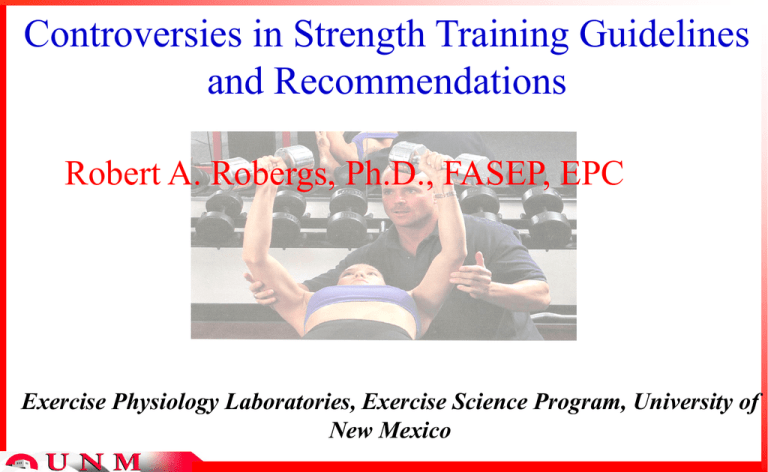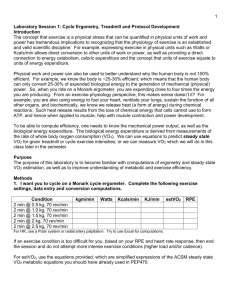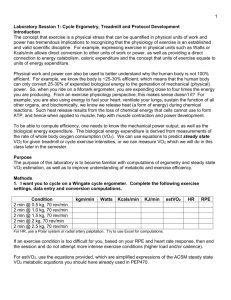Controversies in Strength Training Guidelines
advertisement

Controversies in Strength Training Guidelines and Recommendations Robert A. Robergs, Ph.D., FASEP, EPC Exercise Physiology Laboratories, Exercise Science Program, University of New Mexico Background • Of all of the disciplines/topics in Exercise Science, strength training clearly has the smallest empirical base of research support. • Concerns over research-supported practice were raised in responses to the ACSM Position Stand. American College of Sports Medicine. Kraemer WJ. Position Stand: Progression models in resistance training for healthy adults. Med Sci Sports Exerc 2002; 34: 364-380. • Identification of deficient research areas can stimulate needed research, and refine current strength training recommendations. Ralph N. Carpinelli, Robert M. Otto, Richard A. Winett. A Critical Analysis Of The Acsm Position Stand On Resistance Training: Insufficient Evidence To Support Recommended Training Protocols. JEPonline 2004;7(3):1-60 Strength Training Controversies 1. Machines vs. Free Weights • Is one of either machines or free weights superior for strength, power or endurance? • No. 2. Short vs. Long Repetition Durations • Are contactions that are < 1-2 s more effective than longer duration contractions in stimulating strength gains? • No. 3. Number of Repetitions • Are 5-6 repetitions to failure/set superior for strength gains than sets with more repetitions? • No. Data suggest that gains are similar for 3 to 20 repetitions. 4. Number of Sets – Untrained Subjects • Are strength gains larger when untrained subjects perform multiple sets? • Insufficient evidence! Most research reveals that 1 set is sufficient for optimal strength gains. 5. Number of Sets – Resistance-Trained Subjects • Do trained subjects need more sets? •No. Most research reveals that 1 set is sufficient for optimal strength gains, even for trained subjects. 6. Rest Interval Between Sets • Does increasing rest between sets improve strength training adaptations? • Insufficient evidence! 7. Exaggerating the Eccentric Component • Is there an added benefit to training when only doing the eccentric component of a muscle action? • No! 8. Number of sessions/week • Is an increased frequency of training above 3/week beneficial for improved strength gains? • Although a seemingly logical recommendation, there is no research support for this belief, not even for highly trained athletes! 9. Split Routines • Does the use of split routines to increase training volume increase strength gains? • Although a popular practice, there is no research support for split routines, not even for highly trained athletes! 10. Periodization in Training • Do greater strength gains result from application of periodization principles in a long-term training program? • No research evidence! 11. High Repetitions and Muscular Endurance • Does muscular endurance increase more when performing training with high repetitions? • No research evidence! 12. Explosive Multiple Set Lifting • Does muscular power increase more when performing rapid or explosive contractions over multiple sets? • No research evidence! 13. Hypertrophy • Is muscle hypertrophy increased more with high resistance and volume training? • No research evidence! Recommended Research Topics In Resistance Exercise and Training • Machines vs. Free Weights • Number of repetitions/set • Number of sets/session • Velocity of muscle contractions • Explosive contractions for muscular power • Optimal recovery between sets Hypertrophy vs. Hyperplasia????? Slow-twitch fiber Fast-twitch fiber Hyperplasia probably occurs in serious body builders, but we cannot detect it in humans myosin-ATPase stain preincubation pH=4.6 Fast-twitch oxidative fiber • What have we done at UNM to contribute to the exercise physiology of resistance exercise? Recent Research From UNM What is the decrement in strength as RM Increases? Can we more accurately predict 1RM strength from multiple RM tests? 70 subjects (34 men, 36 women) 1, 5, 10 and 20 RM Testing for Chest Press and Leg Press We graphed strength decrement across RM values We calculated 1 RM from 5, 10 and 20 RM tests Estimating Multiple RM Load Estimating Multiple RM Load 1 RM Prediction from 5 RM Conclusions • Leg Press 5 RM = 85.91% 1RM 10 RM = 70.1% 1RM 20 RM = 51.6 % 1RM • Chest Press 5 RM = 87.45 % 1 RM 10 RM = 75.65 % 1 RM 20 RM = 61.61 % 1 RM • Multiple regression to predict 1 RM most accurate from 5 RM test Leg Press 1 RM (kg) = (1.09703 x 5 RM kg) + 14.2546 Chest Press 1 RM (kg) = (1.1307 x 5 RM kg) + 0.6998 Recent Research From UNM Can we more accurately estimate energy expenditure during strength training? If so, what is this energy expenditure for a given load and distance the load is lifted? 43 male subjects (23 for chest press, 20 for parallel squat) In Press: Journal Strength and Conditioning Research. 2006 Problem Expired gas analysis indirect calorimetry Accounted for body weight in load lifted Measured vertical distance the load was lifted Computed power and work Used load and distance in multiple regression to predict VO2 Steady State VO2 measured for multiple intensities Linear Regression used to extrapolate VO2 to heavy loads VO2 converted to Kcals/min Compared Kcals to previously published data. Sample Data VO2 (L/min) 4 20 kg 3 2.586 L/min 2 1 0 0 1 2 3 4 5 Time (min) VO2 (L/min) 4 25 kg 3 2.702 L/min 2 1 0 0 1 2 3 Time (min) 4 5 Conclusions • Chest Press VO2 = 0.132 + (0.031 * kg load) + (0.01 * cm lifted) • Parallel Squat VO2 = -1.421 + (0.022 * kg load) + (0.035 * cm lifted) • Kcals = VO2 L/min x 5.05 Kcals/L x distance cm x repetitions • Energy expenditure 2 to 3 times higher than prior research! • Supports observations and logic for high energy demands of resistance exercise. VO2 (mL/kg/min) 37.5 Linear Regression 35.0 32.5 30.0 27.5 25.0 0 10 20 30 40 50 Power (Watts) 60 70 Thank you rrobergs@unm.edu www.unm.edu/~rrobergs



